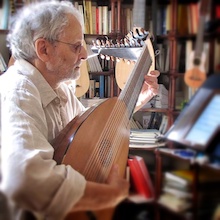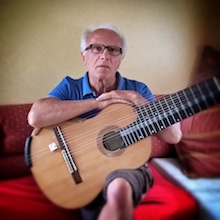Duetto à Liuto e Traverso, in G Major
Allegro
Adagio
Presto
Concerto à Liuto obligato, Violino e Basso, in C Major
Allegro
Adagio
Vivace
Allegro
Largo
Presto
• Composer(s): Ernst Gottlieb Baron (1696-1760)
• Title: The Brussels Manuscript
• Sub-title: Concertos à Liuto Obligato & Duetto à Liuto e Traverso
• Year of edition: c.1760
• Source: B-Br Ms. II 4087
• Volume: 2
The Brussels Manuscript
Baron's works are characterized by a baroque idiom heavily influenced by the galant style. Many are contained in a series of manuscript fascicles in French tablature, kept today at the Bibliothèque Royale Albert I of Brussels, under the reference B-Br Ms. II 4087. Some of these documents belonged to the publisher Breitkopf, who had ordered copies around 1760.
In the course of the 19th century, they were acquired by François‑Joseph Fétis, a musician, musicologist and Director of the Brussels Conservatory, who added them to the tablature collection he had already constituted.
The manuscript contains ten different sonatas for solo lute, a duet for transverse flute and lute and deux concertos for violin, lute and bass. Several pieces of one of the sonatas can also be found in the Haslemere manuscript, with the indication "Weiss". This, however, is considered most unlikely, and the entire sonata is attributed to Ernst Gottlieb Baron. Three of the manuscripts, written in a very clear and recognizable hand, are marked "LAVG", and thus associated with Luise Adelgunde Victorie von Gottsched.
Ernst Gottlieb Baron (1696-1760)
Ernst Gottlieb Baron was born on February 17 1696 in Breslau, the capital of Silesia.
Ernst Gottlieb took up the lute in his childhood. He knew the Weiss family, and in particular Sylvius Leopold, who was nine years older. He also frequented Gottfried Meüsel, his near-coeval, and the Kropffgans family.
In 1715, Ernst Gottlieb studied law and philosophy at the University of Leipzig. The city, however, was also a German musical capital, and it was above all the art of the lute that absorbed his talents, in the company of Anton Wilhelm Heinrich Gleitsmann.
On May 12 1728, Ernst Gottlieb Baron was appointed lutenist at the Court of Saxe-Gotha-Altenburg, replacing his friend Gottfried Meüsel who had just died after falling off a horse. Five years later, however, he resumed his itinerant life-style, before settling for five years in Eisenach.
In 1737, Ernst Gottlieb Baron, again wandering from court to court (Mersebourg, Cöthen et Zerbst), was introduced to Frederick William I of Prussia. The Soldier King hired him as a theorbist in Berlin, and granted him permission to travel to Dresden to be given a théorbe by Sylvius Leopold Weiss. There, Baron had the pleasure, not only of hearing his friend and master, but of meeting several of his students: Wolfgang Adam Anton von Hoffer, Johann Kropffgans, his sister Johanna Eleonora and Timofei Bielogradski, a Circassian bandorist in the employ of the Russian Ambassador and to whom Weiss had taught the lute.
Ernst Gottlieb Baron kept his position at the Court of Prussia when Frederick II the Great replaced his father. As long as he lived, he taught and pursued his encyclopedic research into the lute and its music.
He died in Berlin on April 12 1760.
Jean‐Daniel Forget | Le Luth Doré ©2015
Duetto à Liuto e Traverso, in G Major
Allegro
Adagio
Presto
Concerto à Liuto obligato, Violino e Basso, in C Major
Allegro
Adagio
Vivace
• Editor(s): Jean-Daniel Forget & Guy Grangereau
• Music period: Baroque
• Instrument(s): 11c/13c Baroque lute
• Instrumentation: Baroque lute solo
• Notation: French tablature
• Modern edition: Urtext
• Publisher: Le Luth Doré Urtext Editions
• Year of publication: 2015
• Collection: Lute and Theorbo Music Collection
• Pages: pp. 80
• Dimensions: 230x310 mm
• Weight: 0,320g
• Binding: Section sewn glue binding
• ISMN: 377-0-0017-8819-7

Passionate about the baroque era, Jean-Daniel Forget is a self-taught lutenist. In order to play the forgotten (lute) works of the 17th and 18th centuries, he has copied (and studied) their manuscripts for almost 20 years.
A long career as a computer scientist, having made him expert in programming, allowed him to utilize the normal logic of writing music, especially that which transcribes tablature for instruments with fretted strings.
In collaboration with Guy Grangereau. he has posted his tablatures on a public internet site that is frequented by many lutenists and guitarists.
Forget was enlisted by Miguel Serdoura to help prepare the musical examples for his fine Method of the Baroque Lute. Further on, he continues to assist Serdoura in the preparation of his (lute) editions.

Guy Grangereau is a professional musician who studied guitar playing in Paris, notably with the Brazilian Turibio Santos. Then, he perfected his musical knowledge at Martenot school in Paris.
Since 1984, he gave guitar and piano lessons and, for twenty years, he taught guitar in music schools.
His favorite instrument is a guitar (Maurice Dupont) initially with 13 strings, to which a 14th string was added; more recently were added two strings and a theorbo neck for the last four strings. This 16 strings instrument can be tuned in thirds (open tuning); he uses it to transcribe solo harpsichord works. He also plays a 14-course theorbed baroque lute (Stephen Murphy).
Since 2010, he is collaborating with Jean-Daniel Forget for the copy of German baroque lute manuscripts of the 17th and 18th centuries, in bringing more particularly his musical expertise to the review of the Silvius Leopold Weiss’ work.
Le Luth Doré Urtext Editions
The Le Luth Doré Urtext Editions offer musicians and musicologists worldwide reliable and authoritative musical texts. The main features are:
• superb and aesthetically appealing music engraving
• optimized for practical use (page turns, fingerings)
• books originally in Italian tablature are published in both Italian and French tablatures
• high-quality and durable (cover, paper, binding)
• both original and modern prefaces, documentation of the corrections made and explanatory footnotes in English, French, Italian, German …
About Le Luth Doré Urtext Editions
Our editions are urtext: we strive to provide reliable musical texts that are as true as possible to the existing sources and the composer’s intentions. We are aware, of course, that it is impossible to reconstruct the one and only urtext. Often, several manuscript sources exist for the same piece, and there is little reliable guidance for determining which version best represents the composer's intentions.
Although we cannot entirely dissipate historical uncertainty, we can compare texts and correct obvious errors, which sometimes occur even in autograph manuscripts. Sources have been meticulously examined - note by note, mark by mark.
The most important observations and editorial decisions are elucidated in the prefaces, in the critical commentary, in footnotes, or marked as such in the musical text. It therefore comes as no surprise that an editor has to invest a great deal of patience, knowledge and time when piecing together an urtext that is true to the source and, hopefully, to the composers’ intentions as well. Proven specialists with extensive knowledge and experience edit our Le Luth Doré Urtext Editions in close cooperation with our Editorial Department.
Each verified musical text preserves the original fingerings and notation of ornamentation and, in the absence of original manuscript notations, also sets forth helpful suggestions by modern masters regarding useful fingerings and ornaments faithful to historical style, as a stimulus to further thought and a starting point for the student's approach to performance.
We are deeply grateful to all the extraordinary musicologists, music teachers and artists that put their knowledge and experience at our disposal for Le Luth Doré Urtext Editions.
Le Luth Doré ©2015